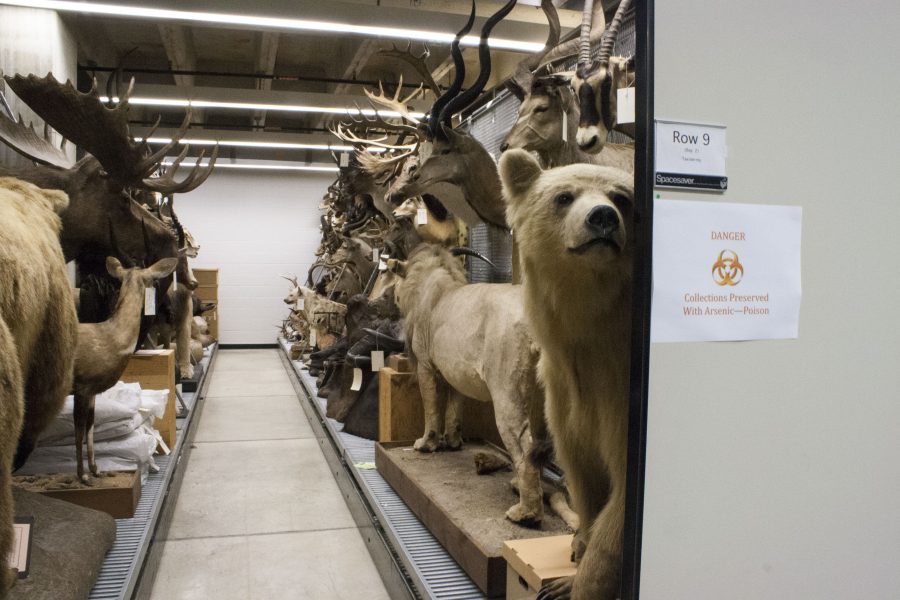On the third floor of Mary Harmon Bryant Hall, there is a place where the past lies dormant behind locked doors. Its existence is a mystery to the students walking outside, and it contents cover millions of years of history ranging from the tusk of a prehistoric Siberian Wooly Mammoth to a pair of Nazi binoculars from a Panzer tank.
Just beyond the door, the room lays dark, and the outline of row after row of compact shelves is in eyesight.
With a wide, pointy smile and a quiet surge of energy, Mary Prondzinski, Collections Manager, flips the row of switches to turn the lights on.
Prondzinski got her undergraduate degree in Biology and Wildlife Management at the University of Arizona. She has worked a total of 17 years in museums such as The American Museum of Natural History in New York City, The Field Museum in Chicago, and the Fairbanks Museum in Vermont. Now, she calls the Alabama Museum of Natural History her home.
“This collection has a lot to offer,” said Prondzinski.
She quickly turns the hand crank to open the first aisle of the tour.
There are at least a hundred furry faces staring lifelessly into the distance. This is an aisle of taxidermy. Full, stuffed lions in different stages of roaring and the toothy grin of a bear seem to face off in an everlasting struggle. Javelinas, moose, eagles, foxes, hyenas, deer, bears, hawks, water buffalos, armadillos, bobcats and many more animals seem to be frozen in time.
“Most of these were large private collections that were donated around the 1980s and 1990s,” she said. “A lot of times you get hunters that want to downsize or their children don’t want this stuff, so they donate it to museums.”
She also explained that taxidermy in museums is always a controversial exhibit. It is politically incorrect, but it is also a teaching tool. Therefore, many times, museums will take the donated collections and store them away for special events.
A few isles over, is the Shamrock Butterfly Collection. Eighty thousand butterflies make up the whole collection—with many more unpinned specimens. In glossy, wooden boxes from the early 1900s are butterflies of all colors and sizes. Each one is pinned with precision.
“It was certainly a difficult process, because normally this was done by men with big hammy hands,” she said.
Next, sitting uncovered on a bottom shelf, is a hippopotamus skull. It is full of cracks and has an off-white appearance.
“People used to have these in their Victorian cabinets,” she said. “They were cabinets of curiosities that people would display things they got in their travels.”
Finally, the shrunken heads. First, were the two fake ones. These were covered with small strands of human hair and the faces were carved from leather stretched over a wooden bust. The eyes and mouth were minimally detailed; it must have fooled someone at some point.
“Sometimes they would use primates because they looked more real than humans,” she said.
The real one was something else entirely. The skin was darker, and the eyes, nose, and mouth sockets were sown together with a worn twine. The hair was faded, and it smelled faintly of tanned leather.
“We have a lot of our butterfly collection by a man named Valentine; well his wife had this and donated it,” she said. “We aren’t sure how she got it, but it originates from Ecuador.”
She then explained the process of how shrunken heads were made. The skin around the skull is removed and it is boiled to reduce the size. It is usually filled with rocks and then left to dry. For many years, they were sold to tourists.
There are over a million more items in this collection: a model ship, paintings, shark teeth, Civil War uniforms, WWII helmets, Native American headdresses, and fossils from every age. It all sits compacted in this long hallway, filled with hidden mysteries.
Mary Prondzinski hopes that students will go visit some of the museums on campus, and see some of the rich history that has been accumulated over the years.
“I wanted to work at an academic institution and I wanted to move to the South,” she said. “Well, I’ve been here a year, so the rest is history.”









